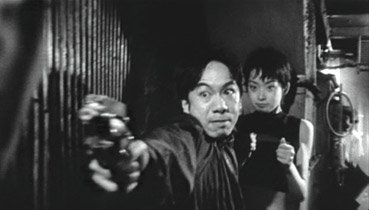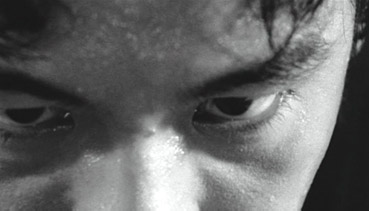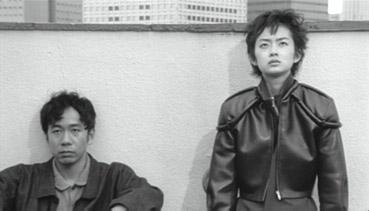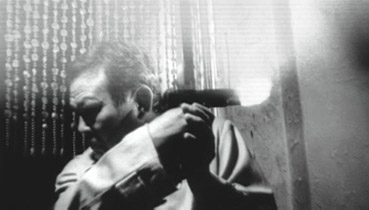|
If
there were awards for great titles, then Bullet
Ballet would surely be up for a gong or two.
Neatly suggesting a blend of violence and elegance, it sounds
like the perfect Hong Kong era John Woo film, an all-action
but balletic explosion of the slow-motion gunplay that became the director's
trademark. But this isn't John Woo, this is Tsukamoto Shinya,
a director whose deeply personal style is a million
miles from Woo's slickly assembled action works. Tsukamoto's
concerns are more localised to the city in which
he lives, to his own neighbourhood and even his own body, and
his cinematic style is far edgier and more dangerous.
Which is not to knock Woo in any way, but at a time when
Woo is making vacuous nonsense like Paycheck,
Tsukamoto is making A
Snake of June. He is one of those rare
directors who has never sold out and never compromised
his vision. Tsukamoto is the very personification of
a great outsider film-maker.

For
a while, a great title is all Bullet Ballet was, at least in the UK. After the cult international
success of Tuskamoto's breakthrough Tetsuo films, British
distributors all but turned their back on the director, and tracking
down his work has proved a task and a
half over the years, especially for someone not located near a big
city and its independent cinemas. Tokyo
Fist eventually made it out on video,
a good friend in Japan sent me both Soseiji and A Snake
of June on DVD, but Bullet
Ballet proved insanely elusive. As if the title
wasn't mouth-watering enough, I kept hearing the likes
of Mark Kermode going on about how great it was, all
of which was driving me slowly potty. Finally I tracked down
a non-anamorphic DVD with English subtitles
from Chinese distributor Fejui and the film proved to be everything I'd
hoped. But this disk played odd games with my DVD player/TV
combination and, like Manga's recent UK release
of Tokyo Fist, was far from ideal. Which
is where, seven years after the film first appeared, Arts Magic
step in. Well, sort of.
In
some ways Bullet Ballet is a
companion piece to Tokyo
Fist, which immediately preceded
it. In both films Tsukamoto himself plays a faceless salaryman
(his character here, Goda, is strikingly similar to
Tsuda in Tokyo
Fist) who loses his girlfriend early in the story. While in the earlier film she deserts him for a boxer
whose vicious physicality she is attracted to, in Bullet
Ballet she kills herself with a handgun. In
both films the response of Tsukamoto's character is
to embrace the source of the violence in an effort to
comprehend and somehow rectify what has happened – Tsuda
takes up boxing to confront the man who has stolen his
girl, while Goda goes in search of a the exact same
handgun that his girlfriend turned on herself in order to similarly confront his own incomprehension
and despair. But chance intervenes in the shape of Chisato,
a girl he believes he has saved from being hit by a train
(we later discover that the danger she appeared to be
in was part of a risk game that she and her cohorts play), an encounter that
ends in him being beaten senseless by the rest of her gang, a scene
that mirrors the pounding Tusda takes in Tokyo
Fist when he confronts the boxer. Having had
no success in tracking down the gun, Goda constructs
one of his own and returns to take on his attackers,
but the gun misfires and he takes a further pounding.
Finally he tracks down the weapon for which he has been searching and becomes furnished
with a purpose. Following a further abortive attempt
to take on the gang, his fate becomes linked with theirs
and specifically Chisato, after she and her friends
are targeted for death following a gang war killing
of – yes – a boxer. At this point it almost feels as if
the narratives of the two films have briefly intersected.

Pretty
much all of Tsukamoto's favourite themes are present
here, the most prominent being the deadening effect
of the corporate world and the need to violently escape it in order to find your real self and experience genuine emotion – as with Tokyo
Fist and Marina de Van's recent Dans ma
peau, this is achieved through the experience of physical pain and the destruction of
the body. The film also shares with David Lynch's Blue
Velvet a fascination with the darker substructure of everyday society (first triggered
here metaphorically, as it was in Tokyo
Fist, when the lead character
catches sight of a dead animal in an alleyway), whose representatives here are the group of drug-addicted young wannabe
gangsters that Goda confronts and eventually sides with.
Central to this journey through the Tokyo underworld
is Goda's relationship with the gun he is desperately
trying to buy, which becomes a link to his lost love (he tries
to understand why she killed herself by recreating the
physical conditions of her death), an instrument of
revenge for the beating he has taken, a club to physically
punish himself with, a bargaining tool used by Chisato
to enlist his help, and a prop to restore an abstract
notion of manhood that has become drained from a society in which men once were warriors.
There are a few direct references to Taxi Driver (one of Tsukamoto's favourite films), but anyone expecting
the sort of cathartic bloodbath that climaxed Scorsese's
masterpiece is in for a surprise – a final confrontation
does take place and guns are fired, but despite his
determination to be something more than he is, Goda
is no warrior and almost nothing about this extraordinary
scene plays out how movies have led us to expect.
Although
it immediately followed Tokyo
Fist, stylistically Bullet Ballet represents the most obvious transition from the anarchic
sensibilities of Tetsuo to the more
formally composed beauty of Sôseiji,
it's high grain black-and-white photography, twitchy
long-lens camerawork and sometimes ferocious editing
(the sequence in which Goda creates, perhaps in his
mind, a montage of increasingly destructive gunshots
to a metal techno beat is a genuinely stunning slice of kinetic
cinema) recall the director's notorious debut, but the
subtextual complexity is very much that of a man who
has mastered his craft and is exploring new directions
in which to take it, while at the same time staying true to and expanding
on his chosen themes.

Although
similarly dark in tone to Tokyo
Fist, Bullet Ballet is ultimately a more optimistic film (Tsukamoto
himself regards it as one of his more anxiety-ridden
works). The city still exerts a power strong enough
to distort image on screen, and physical suffering is
still seen as an inevitable part of awakening from the
corporate daze, but here Tsukamoto offers hope in the
shape of the light and space Goda draws strength from
before battle and later flees hungrily into, liberated
and transformed by his experience. As are we. Bullet
Ballet is in the very best sense typical Tsukamoto
– charged, confrontational, rule-breaking and at times
electrifying. It's a film that drags you mercilessly into the darkness
before spitting you back out into an uncertain but inexplicably
thrilling light.
Though
shot on 35mm, Tsukamoto has elected to use high speed
black-and-white stock that produces a grainy, rough-edged
image that may not look pristine on DVD but most definitely
suits the film. Framed at 1.85:1, the transfer is something
of a mixed blessing – it scores heavily over the Fejui
disk by virtue of its anamorphic enhancement and a decent
level of sharpness (within the restrictions of the original
material), but the contrast levels vary quite a bit,
with strong black levels in some shots giving way to
grays in others. The contrast may be a little heavy
on the Fejui disk, but it is consistent and blacks are
blacks there.
There
are two sound mixes on offer, Dolby 2.0 stereo and 5.1
surround. Though the full sound stage is not really
put to use (despite some whisperings in the rear speakers
during city exteriors), the 5.1 track definitely has
a fuller and richer feel. Subwoofer activity is surprisingly
low.
One
of the two principal extra features here must be the commentary
by Tom Mes, asian cinema expert and author of
the upcoming Iron Man – The Cinema of Shinya Tsukamoto.
A gentle talker, Mes largely refrains from interpreting
the subtextual elements of the film to concentrate on
some very solid background and technical details, outlining
the social element of the locations, how key scenes were
shot and informing us that though the film looks as if
it was shot guerilla style, permission was actually obtained
for the vast majority of filming. He also reveals that
Tsukamoto chose to make this in black and white so that
it would have the steely gray look of a gun, and that the
film was inspired by a true incident when Tsukamoto himself
was assaulted by a gang near his office.

Interview
with director (34:34) is shot on video and framed 4:3 (with Tsukamoto's
head sitting dead centre in frame, what we used to call
'gunsight photography') and chaptered by a series of very
good on-screen questions. Tsukamoto talks in detail about
a variety of aspects of the film and his career, including
shooting hand-held and giving the film a deliberately
documentary feel, the influence of the photographs of
Larry Clark, the interaction of the city and the human
body, the (by Japanese standards) luxurious four month shooting
schedule, and film's social and thematic aspects. This
is all very interesting stuff, and runs for a good length.
Bio/filmographies are provided for director Tsukamoto and actors
Igawa Hisashi, Mano Kirina and Suzuki Kyoka. Tsukamoto's is very
detailed, the others are extraordinarily brief – although
listing all of his films, Suzuki's biography has
been whittled down to "Born on 31st May 1968 in Sendai."
Promotional
material consists of a single screen featuring the cover and inset
of the programme notes containing all of the film's credits.
Trailers has two short Japanese trailers for the film. They are
identical save for a selection of critical quotes that
precede Trailer 2. As trailers go, this captures the energy
and feel of the film very well. Unusually but pleasingly,
both have removable English subtitles.
A
terrific Tsukamoto Shinya study of the interaction between
the city and the human body gets pretty decent treatment
by Arts Magic, with an anamorphic transfer, an informative
commentary track and a consistently interesting interview
with the director to recommend it. A shame about the contrast
on the transfer, though – this jumps about quite a bit
and lets an otherwise strong disc down just a tad. But this
will do for now, and I'd still give it the edge over Manga's Tokyo Fist disk on the basic of the anamorphic picture and the extras,
and it's a seriously impressive slice of on-edge cinema
that has been too-long unavailable.
|